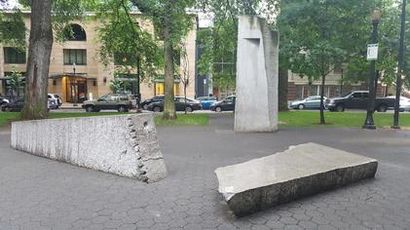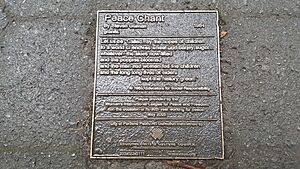Peace Chant facts for kids
Quick facts for kids Peace Chant |
|
|---|---|

The sculpture in 2016
|
|
| Artist | Steve Gillman |
| Year | 1984 |
| Type | Sculpture |
| Medium | Granite |
| Location | Portland, Oregon, United States |
| 45°30′55″N 122°40′59″W / 45.51535°N 122.683189°W | |
Peace Chant is a special outdoor sculpture created in 1984 by an artist named Steve Gillman. It's made of granite, a strong type of rock. You can find it in Portland, Oregon, specifically in the South Park Blocks area, at Southwest Park Avenue and Southwest Columbia Street.
Contents
About the Peace Chant Sculpture
This sculpture is very important because it was the first peace memorial known in Oregon. A memorial is something built to help people remember an important event or idea.
Why Was it Built?
The idea for Peace Chant came from Steve Gillman. He wanted to create a quiet spot where people could sit and think. He also wanted the sculpture to show his strong belief in peace. Nearby churches also supported the idea of peace.
The money to build Peace Chant came from two groups. These were the National Park Service and the City of Portland's Housing and Community Development department.
What Does it Look Like?
The Peace Chant sculpture is made of three tall, large pillars. These pillars stand together as a symbol.
Next to the sculpture, you can read a poem that Steve Gillman chose. It talks about hope and a peaceful world:
Let us be "Called...by the hopes of children
to a world of endless wheat and barley sugar...
whatever--the skies now lifted
and the poppies bloomed
and the men and women fed the children
and the long long lives of elders
kept the history green."
Meaning of the Sculpture
The Smithsonian Institution is a famous group of museums and research centers. They describe Peace Chant in two ways. It is considered both abstract and allegorical.
- Abstract art means the sculpture doesn't show things exactly as they look. Instead, it uses shapes and forms to express feelings or ideas.
- Allegorical sculpture means it represents a bigger idea or message. In this case, the sculpture stands for "peace."
In May 1985, the City Council decided to name the block where the sculpture stands "Peace Plaza." This name helps remind everyone of the sculpture's message.


